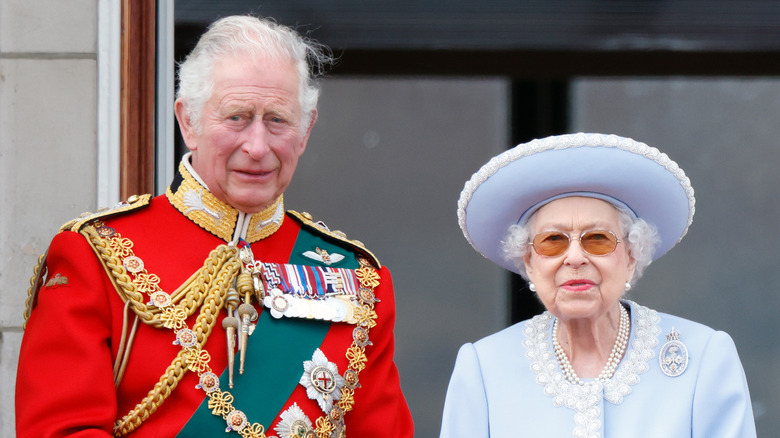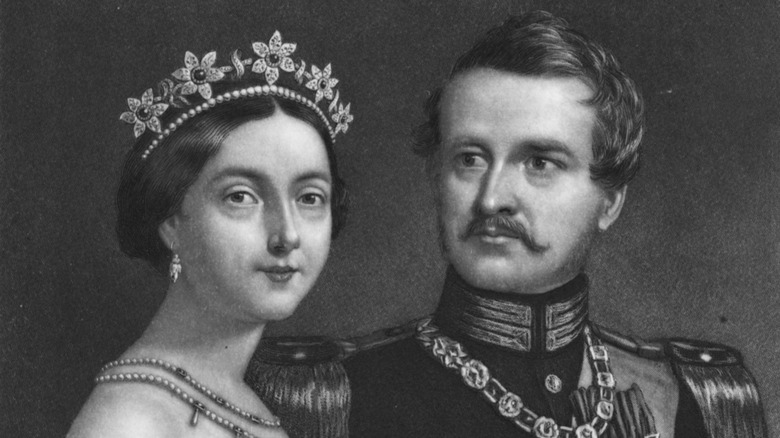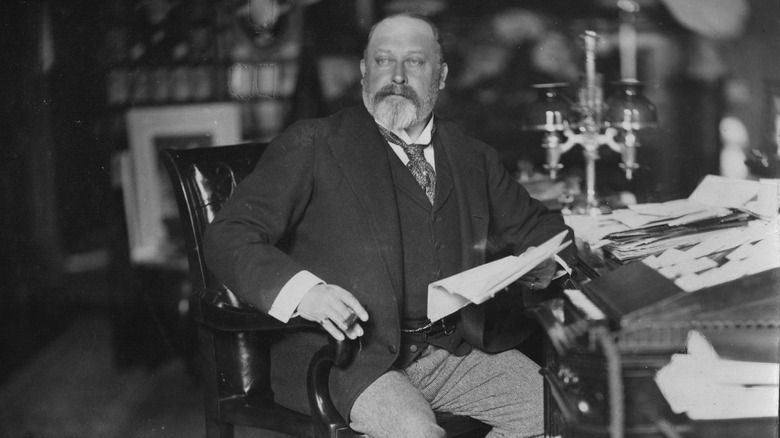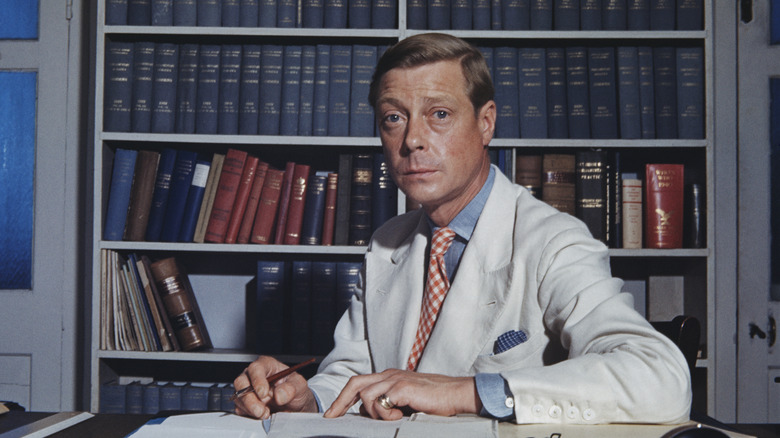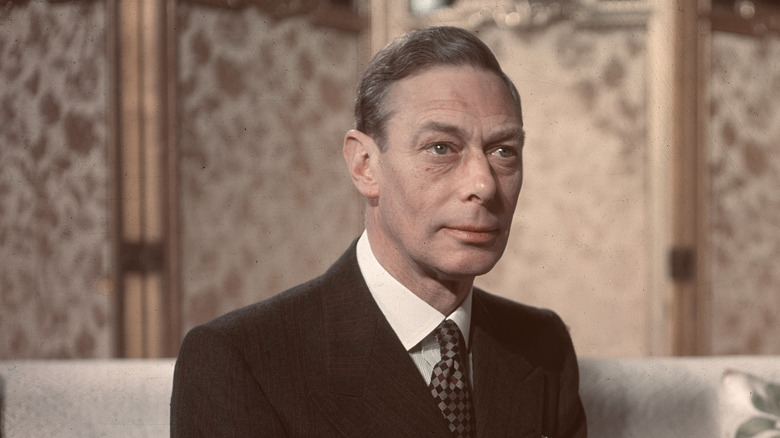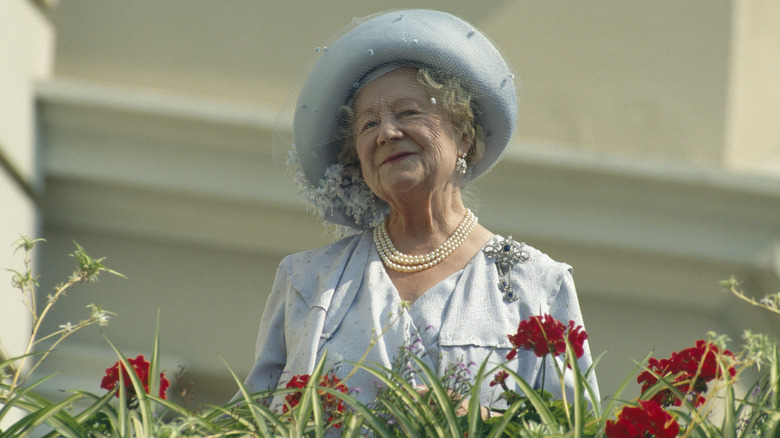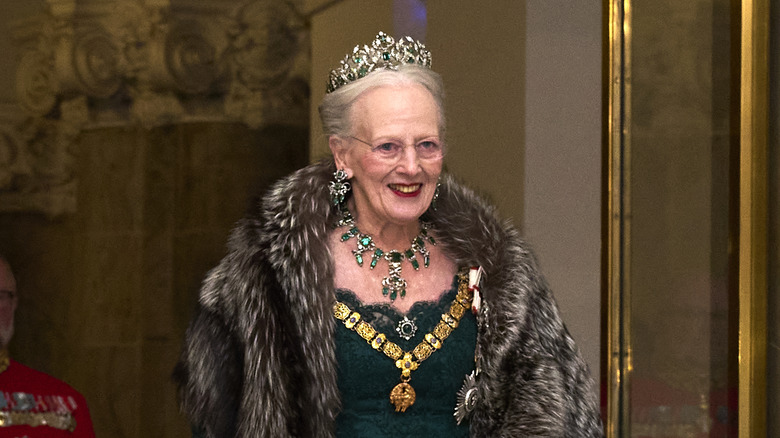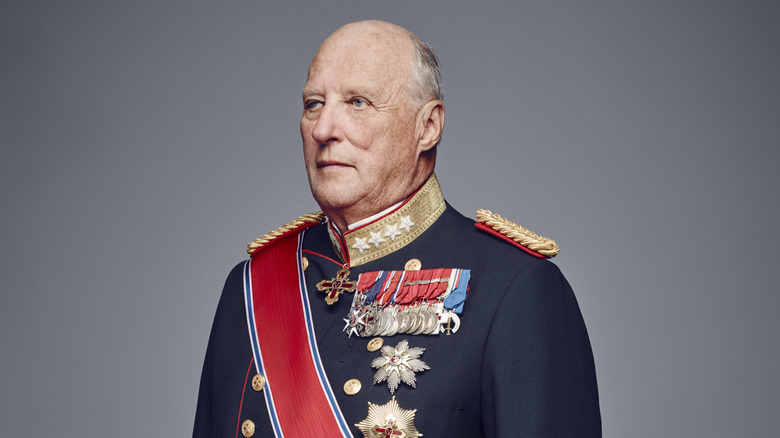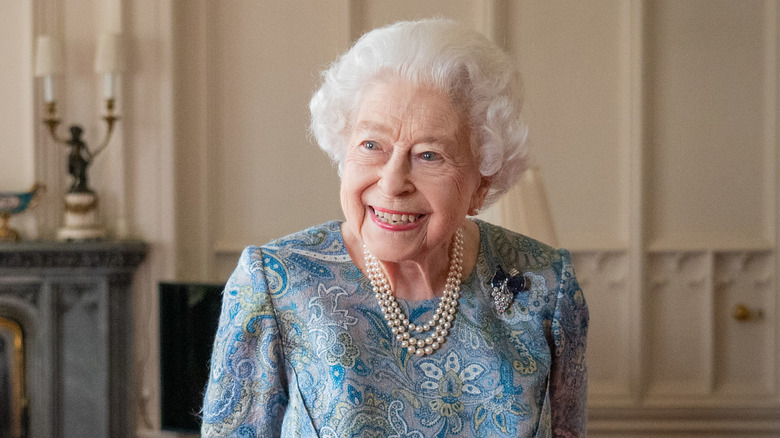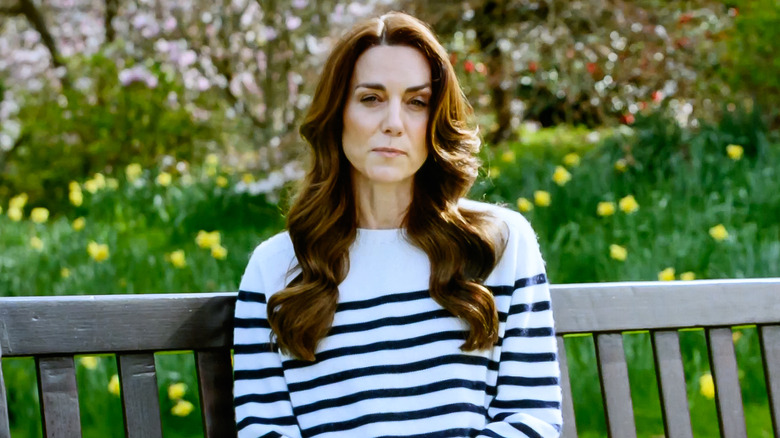The History Of Royals Who Were Quietly Diagnosed With Cancer
In February 2024, King Charles III shocked the world when he revealed that a medical treatment for an enlarged prostate unexpectedly revealed a shocking diagnosis. "Subsequent diagnostic tests have identified a form of cancer," Buckingham Palace said in a statement. While the king didn't detail which particular form of the disease he'd been stricken with, the fact that he went public with the news was something of a break from tradition for Britain's royal family. In fact, the level of transparency displayed by Charles about his health was the exception, not the rule, given the royals' long history of keeping any type of medical malady a secret from the public.
Revealing illness may be viewed as a sign of weakness by royals, but despite their highborn status and regal bloodlines, they're still human beings who are subject to the same health woes that can befall anyone. That has certainly been the case when it comes to cancer, and Charles is not alone among royalty to be diagnosed with this potentially deadly disease — something that became clear when another member of his family — Catherine, Princess of Wales — made a subsequent public announcement of a cancer diagnosis, mere weeks after Charles' revelation.
Over the years, cancer has impacted numerous royals who, as has been their habit, haven't typically been forthcoming regarding sharing details of illness with the world. To find out more, keep on reading for a look back at the royals who were quietly diagnosed with cancer throughout history.
Emperor Frederick Wilhelm and Empress Victoria both died from cancer
Victoria, Princess Royal, was the eldest child of Queen Victoria and her husband Prince Albert. Nicknamed Vicky, she went on to marry Prince Frederick William of Prussia (who also had a nickname, Fritz). He became emperor in 1888 after the death of his father William I, and held the dual titles of King of Prussia and Emperor of Germany, with Victoria becoming empress. Sadly, his reign as emperor was a brief one; a heavy smoker, Frederick was diagnosed with cancer of the larynx shortly after his ascension to the throne. He declined an operation to remove the tumor, which he judged to be too risky but was eventually forced to undergo a tracheotomy when the growing tumor in his throat threatened to choke him. Frederick's reign lasted just 99 days before the cancer took his life.
The widowed Victoria lived out the rest of her days as empress dowager, continuing to hold the title Empress Frederick. Like her husband, Victoria was also stricken with cancer. While definitive information about her illness will likely never be known, the doctors who diagnosed her with breast cancer deemed it to be inoperable. She died at the age of 60 in 1901.
The couple's eldest son, Kaiser Wilhelm II, reigned until 1918 when he was forced to abdicate the throne after Germany's humiliating loss in World War I. He lived out the rest of his days in exile in the Netherlands.
King Edward VII was successfully treated for skin cancer
The younger brother of Empress Victoria, King Edward VII was the second child of Queen Victoria and Prince Albert. As the oldest male child, he was first in the line of succession when his mother died in 1901, and his coronation was scheduled for June 26, 1902. Weeks before the coronation, however, the king's appendix ruptured, which subsequently led him to develop a serious infection. Doctors cautioned that if he did not undergo immediate surgery he would likely die. The king, however, balked, initially insisting that he could soldier on during the ceremony on the pre-ordained date. However, his physicians eventually convinced him of the gravity of his condition; he reluctantly agreed to postpone the coronation and have the operation. He ultimately made a full recovery.
During his reign, the king — who'd been nicknamed Bertie — received a diagnosis of basal-cell carcinoma, a common form of skin cancer that typically develops on areas of the body that are regularly exposed to sunlight, predominantly the face. That was the case for Edward VII, whose skin cancer was near his nose. He was treated with radium — a fairly new and experimental procedure at that time, but one that worked. The radium treatment reportedly cured him, leaving the king free of skin cancer.
Cancer was not reported to be a factor when he died in 1910 at 68, having served as king of England for less than 10 years.
The Duke of Windsor died a year after being diagnosed with throat cancer
Decades after his death, the Duke of Windsor remains a notorious figure; after all, it was his desire to marry divorced American Wallis Simpson that led him to abdicate the throne of England, ultimately resulting in his brother becoming king and being succeeded by Queen Elizabeth II. Then, of course, there was the posthumous revelation that the erstwhile former King Edward VIII was also a Nazi sympathizer who felt that Britain should have appeased Adolf Hitler, not gone to war against him.
The duke spent the remainder of his life in exile, living in France. He experienced ill health in his later years and died in 1972 at the age of 77. At the time of his demise, according to his obituary in The New York Times, a Buckingham Palace spokesperson stated, "He died peacefully." According to the Times, he'd recently undergone a hernia operation; when asked about the cause of death, the duke's secretary John Utter responded, "Just natural causes."
That, however, was subsequently revealed to be a lie; as The Tatler reported, the actual cause of death was laryngeal cancer. In the documentary "Queen Elizabeth II," reported by the Daily Mail, the duke's former nurse Julie Alexander confirmed that when the queen paid her uncle a final visit, she knew the extent of his illness. "He was terribly sick. He couldn't have weighed — maybe 80 lbs, if that ... [he] wasn't eating at all," Alexander said.
King George VI's lung cancer was kept secret
In the wake of his older brother's abdication, King George VI became monarch in 1936. The king had been a heavy smoker since his youth, reportedly consuming in excess of two packs each day. All those cigarettes led the monarch to experience numerous health woes as he grew older, including a blocked artery in his leg that required surgical intervention in 1949.
In September 1951, he was diagnosed with lung cancer and underwent surgery. At the time, however, that diagnosis was not revealed — not publicly, nor even to the king himself. "The decision to operate was taken on Friday after doctors noticed 'structural changes' in the King's lung, which were giving cause for concern," declared a 1951 report from BBC News, parroting the official line from Buckingham Palace. While the king's doctors were clearly aware that the cancer had spread, and the prognosis was terminal, those same doctors declined to share that information while bragging to newspapers about the king's supposed recovery. "The King is the best patient I ever had," said royal surgeon Clement Price Thomas (via Time). "Not only is he brave, but he is full of humor."
Just five months later, in February of 1952, King George VI died in his sleep at the age of 56. The official cause of death was said to be a heart attack but has since been widely acknowledged to have resulted from lung cancer.
The Queen Mother's multiple cancer diagnoses were kept under wraps until her death
The Queen Mother — widow of King George VI and mother of Queen Elizabeth II and Princess Margaret — was something of a poster child for longevity. Despite daily imbibing in gin, wine, and champagne, she made it to the ripe old age of 101 when she finally shuffled off this mortal coil in 2002.
What wasn't mentioned until after her death, however, was that the Queen Mother hadn't been as healthy as the public had been led to believe. In fact, she'd undergone treatment for cancer — and not just once.
According to an official biography from author William Shawcross (reported by the Daily Mail), she went under the knife in 1966 after being diagnosed with colon cancer. At the time, the official line from Buckingham Palace was that she'd had an operation to address an intestinal blockage — a fib that backfired when false rumors began spreading that she required a colostomy bag. Then, nearly 20 years later, the public was told in 1984 that the Queen Mother was admitted to hospital to undergo tests, which indicated she was in excellent health. The real reason behind that hospital visit, however, was to have a carcinoma removed from her breast. In both cases, she made a full recovery.
Queen Margrethe of Denmark was diagnosed with cervical cancer
Queen Margrethe of Denmark made headlines in early 2024 when the 83-year-old monarch abdicated, with recent health issues behind her decision to step aside so that her oldest son, Crown Prince Frederik, could take her place on the throne.
The third cousin of Queen Elizabeth II (both queens shared Queen Victoria as great-great-grandmother), Margrethe gained a reputation as a chain smoker for most of her life. In 2006, an announcement declared that she would no longer smoke in public, so as not to encourage Danes to take up the habit — although she continued to puff away in private.
In 1994, Margarethe was diagnosed with cervical cancer, for which she successfully underwent treatment. While there weren't any publicized recurrences of cancer, that wasn't the only health issue with which the Danish royal dealt. During the 1990s and into the 2000s, the queen's knee required several surgical procedures; she ultimately received a knee replacement in 2007. She also had surgery in 2003, for spinal stenosis, and in 2023 underwent major back surgery. The latter surgery, in fact, was a major reason behind her decision to step down from the throne. "The surgery naturally gave rise to thinking about the future — whether the time had come to leave the responsibility to the next generation," she said during a televised address, as reported by Reuters. "I have decided that now is the right time."
King Harald V of Norway received treatment for bladder cancer
Another European monarch with ties to Britain's royal family is King Harald V of Norway; the late Queen Elizabeth II was Harald's second cousin, as both were great-grandchildren of Britain's King Edward VII and Queen Alexandra.
In 2003, the king received a bladder cancer diagnosis. "The treatment is to remove the bladder," said specialist Trygve Talset of Radiumhospitalet, via a report from Nettavision. "Thankfully, he has gotten medical attention at an early stage and there is no reason to believe that the illness has spread. After the surgery, the King will be fully cured." That operation was, as predicted, successful, and the king went on to make a full recovery.
Sadly, subsequent years found Harald — who had been a lifelong smoker — plagued with various other health problems, including issues with his heart, which required surgery in 2005. He subsequently underwent surgery in 2020 to replace the heart valve that had been inserted during the previous operation. In late 2023, the 87-year-old royal was hospitalized while vacationing in Malaysia in order to treat an infection. He subsequently had a pacemaker implanted.
Sarah, Duchess of York underwent treatment for breast cancer and malignant melanoma
Sarah Ferguson became a member of Britain's royal family when she married Prince Andrew in 1986. They separated in 1992, with their divorce finalized in 1996.
In June 2023, the Duchess of York underwent a routine mammogram, which revealed that she had breast cancer. She immediately underwent surgery. The public, however, wasn't informed about the diagnosis until after she'd already gone under the knife. "The Duchess is receiving the best medical care and her doctors have told her that the prognosis is good," a spokesperson said in a statement, as reported by CBS News. In a New Year's Eve Instagram post, reflecting on the events of the past year, the duchess confirmed that the surgery had been a success. "I was diagnosed with breast cancer. I beat breast cancer," she wrote in that post.
Weeks later, in January 2024, a dermatologist was examining some moles while Ferguson was undergoing reconstructive surgery following her earlier mastectomy. That led to the discovery of a cancerous mole, which was removed. "She is undergoing further investigations to ensure that this has been caught in the early stages," explained her spokesperson, via CBS News. "Clearly, another diagnosis so soon after treatment for breast cancer has been distressing but the Duchess remains in good spirits."
Rumors that Queen Elizabeth II was treated for cancer have never been confirmed
When Queen Elizabeth II died in 2022 at the age of 96, her death certificate listed the cause of death as old age. Subsequently, a royal source revealed that the queen's health had been declining for some time. "The secret of her failing health was well guarded, but she had actually been very unwell for a lot longer than most people knew," the source told the Daily Beast.
Could there have been another factor at play other than old age? That's the contention of author Gyles Brandreth, a friend of both the queen and her late husband Prince Philip. In his 2022 book, "Elizabeth: An Intimate Portrait," Brandreth claimed that the queen had been suffering from myeloma, a form of bone marrow cancer, which was a closely held secret within Buckingham Palace. "[It] would explain her tiredness and weight loss and those 'mobility issues' we were often told about during the last year or so of her life," he wrote, in an excerpt appearing in Newsweek.
Dickie Arbiter, who had served as the queen's spokesman from 1988 to 2000, begged to differ and told Newsweek that Brandreth was passing along "secondhand" information. "I don't think anybody knows what it was," Arbiter said of the reason for the monarch's death. "We certainly won't know anything for the next 100 years," he added, pointing to Britain's National Archives policy of keeping royal documentation a secret for a full century.
Catherine, Princess of Wales revealed she was undergoing chemotherapy after abdominal surgery
In January 2024, Kensington Palace issued a statement announcing that Catherine, Princess of Wales had been admitted to a hospital for what was described as "planned abdominal surgery." The recovery process was expected to take a few months, and Kate Middleton wasn't expected to resume public duties until after Easter, in early April. Despite that clearly defined timeline, her absence from the public eye sparked some wild conspiracy theories, which were fueled when a badly Photoshopped photo of Princess Kate and her three kids raised further questions.
The truth finally emerged when she issued a video via social media. "In January, I underwent major abdominal surgery in London, and at the time it was thought that my condition was non-cancerous," she said, noting that tests conducted post-surgery indicated the presence of cancer. "My medical team therefore advised that I should undergo a course of preventative chemotherapy, and I'm now in the early stages of that treatment," she continued, explaining that she needed time to recover from that serious surgery before being well enough to begin chemo.
"This of course came as a huge shock," she added, noting that she and her husband Prince William had been taking time to process this shocking development privately, before announcing the news to the world. "We hope that you'll understand that, as a family, we now need some time, space, and privacy while I complete my treatment," she said.

